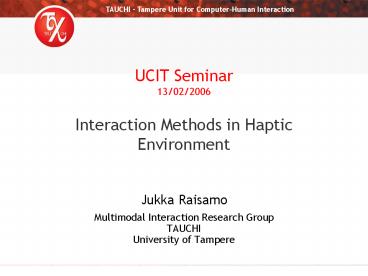UCIT Seminar 13022006 Interaction Methods in Haptic Environment - PowerPoint PPT Presentation
1 / 10
Title:
UCIT Seminar 13022006 Interaction Methods in Haptic Environment
Description:
Tactile. feedback. 2. TAUCHI Tampere Unit for Computer-Human Interaction. Motivation ... How do different properties of touch affect the perceived feedback? ... – PowerPoint PPT presentation
Number of Views:44
Avg rating:3.0/5.0
Title: UCIT Seminar 13022006 Interaction Methods in Haptic Environment
1
UCIT Seminar13/02/2006Interaction Methods in
Haptic Environment
- Jukka Raisamo
- Multimodal Interaction Research Group
- TAUCHI
- University of Tampere
2
A brief introduction
to Jukka..
- Topic of the thesis Interaction Methods in
Haptic Environment - Advisors Kari-Jouko Räihä, Roope Raisamo
- Background M.Sc. in Computer Science, University
of Tampere (2003) - Professional interests HCI, multimodal
interfaces, haptics - Affiliated to UCIT since summer 2003 (funding
2006-2009) - Born in 1977, lives in a common-law marriage,
plays with 11 children - Hobbies include mostly lots of sports and often
inadequate amount of literature plus countless
hours of time spent on the playgrounds
1
3
What is haptics, anyway?
- Derived from the Greek word haptesthai, meaning
to touch - Just a fancy synonym for touch..?
- describe the field of research exploring human
perception and interactions mediated via the
sense of touch - used in context of hardware and software systems
providing touch feedback - Haptic feedback means using touch as a medium for
interaction
2
4
Motivation
- Human perceptual system forms a holistic
experience from the world outside - vision tends to dominate the other senses
- computer interfaces based merely on visual (and
auditory) modalities lack the feeling of reality - Haptic modality can help to create more natural
and informative interfaces, because it - is intrinsically bidirectional,
- provides multi-parametered feedback,
- is either active exploration or passive sensing,
and - helps to make the interaction more emotional.
3
5
Research problems
- The questions risen so far
- How do different properties of touch affect the
perceived feedback? - What are the effects caused by different designs
of the devices? - Where it is at its best?
- How to combine it with other modalities?
- Is it sensible to design interfaces for all?
- How does the haptic memory work?
- How detailed guidelines it is possible to define?
- Design dimensions for haptic research
4
6
Approaches
- Empirical research
- basic research on haptic sensing and interaction
- validate the prototypes
- compare the new interaction techniques and
artifacts with the existing ones
- Constructive research
- ideas
- prototypes
- testing
- publication
5
7
Objectives
- Three phases of research
- I defining thresholds and limits for
- perceiving haptic parameters
- II designing natural interaction techniques
- based on the devices used in the research
- III implementing a prototype environment
- taking advantage of the results
- PhD in 2009
6
8
Goals
- To lay foundations for haptic signal language
- To gain new knowledge on the haptic interaction
- To develop interaction techniques that take into
account the different qualities of the current
haptic devices
7
9
Activities for 2006
- Continue the research on the detectability
thresholds - creating a set of tasks for more exact measures
- comparisons between a greater variety haptic
devices - 2 publications (journal conference)
8
10
Thank you.
- Jukka Raisamo
- jr_at_cs.uta.fi
- www.cs.uta.fi/hci/mmig
9






























